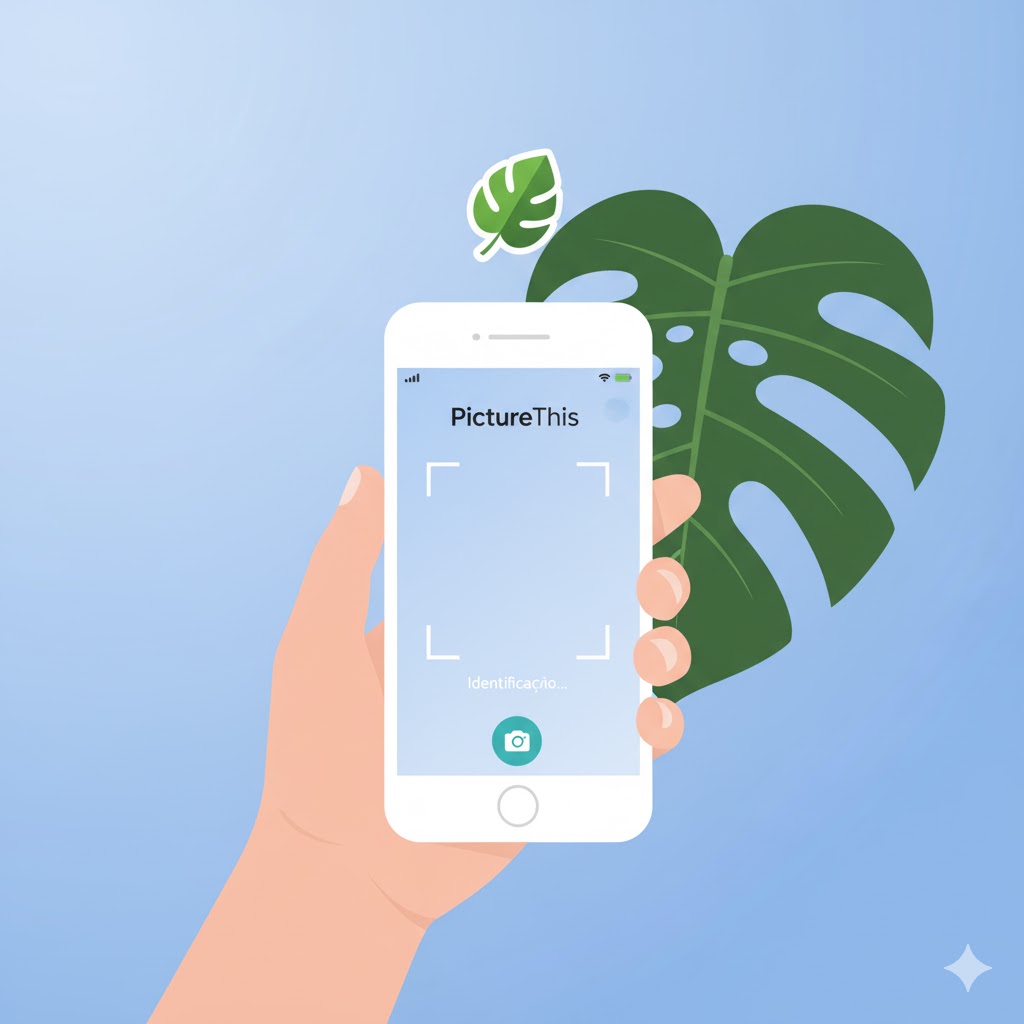You're walking through a park, or perhaps visiting a friend, and you come across a stunning flower or exotic foliage. Immediately, curiosity strikes: "What plant is that?" In the past, this question might have gone unanswered or required hours of leafing through a botanical guide. However, today, the search for applications to identify plants quickly leads us to incredible technological solutions. For those seeking this agility, learning How to use PictureThis to recognize plants is the solution. In fact, speed is essential, as we want the answer while curiosity is fresh.
In this universe of digital tools, one app consistently stands out for its impressive speed and accuracy: PictureThis. Although the title mentions "apps" in the plural, it's nearly impossible to talk about rapid identification without focusing deeply on the app that set the market standard. Indeed, PictureThis isn't just an app; it works like an AI botanist in your pocket, ready to name and contextualize almost any plant in seconds. So, if you're looking for a definitive solution, this article is your complete guide to PictureThis.
What is PictureThis and Why Does It Recognize Plants So Fast?
PictureThis is a mobile app, available for iOS and Android, designed specifically for identifying plants through photos. But what makes it different from a simple Google image search? The answer lies in its core technology. The app uses a deep learning neural network trained on a colossal database containing hundreds of millions of plant images already cataloged by experts.
PictureThis Identify Plant
Android
So when you take a photo, PictureThis's AI isn't just "comparing" your image. It's actually analyzing complex morphological characteristics: leaf shape, petal texture, vein pattern, and even branch arrangement. Because of this intensive training, the app can achieve frequently cited accuracy rates above 98%.
PictureThis's "speed," therefore, isn't just about the software's speed, but about the accuracy of the response. In other words, you don't waste time checking questionable results. Typically, in less than three seconds, you have the scientific name, common names, and a complete file. Understand How to use PictureThis to recognize plants It is, therefore, the first step towards having a botanical in your pocket, which puts it on a different level than many alternatives.
How to Use PictureThis to Recognize Plants (Step by Step)
For those who've never used a plant identifier, PictureThis may seem like magic. However, the process is incredibly straightforward and optimized for beginners. So, if you want to master it, How to use PictureThis to recognize plants in the most efficient way, follow this detailed guide.
Step 1: Downloading and Configuring the App
First, you need to download the app. Just go to the Google Play Store (Android) or the App Store (iOS) and search for "PictureThis." Installation is quick. When you first open the app, it will likely briefly introduce its features and offer the Premium version. At this point, you can opt for the free trial (remember to cancel if you don't want to be charged) or, in many cases, find a small "X" or button to skip and use the limited free version.
Additionally, the app will request permission to access your camera and photo gallery. Granting these permissions is essential for the app to function, whether it's taking a photo on the spot or analyzing an image you've already saved.
Step 2: The Interface and the Identification Button
When you open PictureThis, the interface is clean and focused. You'll immediately notice a prominent center button, usually with a camera or leaf icon. This is your gateway to identification. Tapping it activates your camera, ready to scan.
Step 3: Capturing the Perfect Photo to Recognize the Plant
Without a doubt, this is the most critical step to ensuring accuracy. After all, artificial intelligence is powerful, but it relies on good imagery. So, follow these tips:
- Focus is Everything: Get close to the plant. In other words, don't take a photo of the entire landscape. Ideally, you should frame the most distinct part of the plant, such as a flower, a specific leaf, or a fruit.
- One Plant at a Time: Avoid capturing multiple different species in the same photo. If your plant is in a crowded flowerbed, try to isolate it in the frame.
- Natural Light: The best lighting is diffused natural light (such as on a cloudy day or in light shade). Therefore, avoid direct midday sun, which blows out colors, and very dark shadows, which hide details.
- Clean Background: If possible, try to photograph the leaf or flower against a more neutral background (such as the sky, a wall, or even placing your hand behind it).
Step 4: The Magic of Analysis
After taking a photo (or choosing one from your gallery), PictureThis springs into action. Immediately, you'll see a "scanning" animation that lasts literally a second or two. The app then displays the results.
The top result will appear with a high confidence percentage (e.g., “99% for sure”). The app will provide the main common name (e.g., Adam’s Rib) and the scientific name (e.g., Monstera deliciosa). Additionally, it can also show you some similar species if your photo is a little ambiguous, allowing you to compare them yourself.
Step 5: Exploring Results and Saving
After identification, PictureThis doesn't stop. Instead, it opens a complete file where you can read a detailed description of the plant, its origin, symbolism, and most importantly, care tips. You can then add this plant to your virtual collection, "My Garden." In fact, this is fantastic for creating a record of all the plants you've found or have at home.
Advanced Features (Beyond Just Recognizing Plants)
Many users download PictureThis solely for name recognition, but the app's true value, especially in the paid version, lies in its auxiliary features. Essentially, it becomes a veritable gardening assistant.
Disease Diagnosis (The “Plant Doctor”)
This is undoubtedly one of the most powerful features. For example, do your plant have yellowing leaves? Brown spots? Well, PictureThis has a "Diagnosis" function. The process is similar: you take a photo focused on the diseased part of the plant (a spotted leaf, for example).
The AI then cross-references the visual symptoms with a database of common diseases, pests, and even nutritional deficiencies. Within seconds, it offers a likely diagnosis (e.g., "Fungal attack – Powdery mildew" or "Overwatering"). More importantly, it provides an action plan: how to treat, which products to use (if necessary), and how to prevent recurrence.
Personalized Care Guides
Each plant identified or added to "My Garden" comes with a comprehensive care guide. This isn't a generic guide. Rather, it provides detailed information:
- Watering: How much water and how often? It also explains whether the soil should dry out between waterings or remain moist.
- Light: Does the plant like direct sun, bright indirect light, or shade?
- Soil: What is the ideal substrate mix?
- Fertilizing: When and with what type of fertilizer (NPK) to fertilize?
- Pruning and Propagation: Tips on how to keep the plant healthy and how to raise seedlings.
Watering and Fertilization Reminders
For those who have many plants at home, managing their care routine can be a challenge. PictureThis solves this problem. When you add a plant to your virtual garden, the app automatically creates a care schedule.
This way, you'll receive notifications on your phone telling you, "It's time to water your Adam's Rib" or "Fertilize your succulents." This undeniably eliminates guesswork and helps keep your plants thriving, transforming the How to use PictureThis to recognize plants on how to use PictureThis to to care of plants.
The Community and the Social Side
PictureThis also has a built-in community. Here, you can share your discoveries in the app's feed, see photos of incredible plants identified by users around the world, and even ask questions of other enthusiasts. Ultimately, it's a way to connect your passion for plants with a global network.
PictureThis: Free vs. Premium (Is It Worth Paying For?)
This is the most common question after learning How to use PictureThis to recognize plants: Is it worth paying? The app uses a “Freemium” model.
PictureThis Identify Plant
Android
What Does the Free Version Offer?
The free version of PictureThis is functional but limited. It typically allows a limited number of identifications per day (or week). Additionally, you'll see ads, and access to advanced features like detailed disease diagnosis and comprehensive care guides is blocked or very superficial.
It's perfect for those with a sporadic curiosity: identifying a flower while walking. However, you'll quickly feel the urge to update.
The Exclusive Benefits of the Premium Version
The Premium version (usually billed annually, though sometimes monthly or lifetime plans are offered) removes all barriers. Consequently, benefits include:
- Unlimited Identifications: Scan as many plants as you want, without restrictions.
- No Ads: A clean and straightforward user experience.
- Advanced Diagnostics: Full access to the “Plant Doctor,” with unlimited analysis and treatment suggestions.
- Complete Care Guides: All information on watering, light, soil and fertilization.
- Care Reminders: The watering schedule feature is fully functional.
- Consultations with Specialists (Plant Doctor): On some plans, you can even submit a question directly to a team of botanists and human experts for a personalized diagnosis.
Cost-Benefit Analysis: Who is Premium Recommended for?
So, is PictureThis Premium worth it? The answer depends on your profile.
- For the Occasionally Curious: Probably not. The free version (or the 7-day trial) is enough to satisfy occasional curiosity.
- For the “Father” or “Mother” of Plant: Absolutely. If you have a collection of plants at home (an "urban jungle"), the value of Premium is immense. The cost of the app for a year is often less than the cost of losing a single valuable plant due to improper care or an undiagnosed disease.
- For Landscapers and Gardeners: Likewise, it's an indispensable work tool. The ability to instantly identify plants at a client's site, diagnose pests, and have pruning guides at hand saves valuable time.
Tips for Maximizing Accuracy When Recognizing Plants with the App
We've already talked about the photo, but to really master it How to use PictureThis to recognize plants, some advanced tricks help the AI get the most difficult cases right.
Focusing on the Right Part of the Plant
AI values different information. For example, if the plant is flowering, always Photograph the flower. After all, the flower is the plant's "fingerprint," making it its most unique part. Second, come the leaves. So, try to capture their arrangement on the stem (whether they're opposite or alternate) and the shape of a mature leaf. Fruits and the texture of the trunk (in the case of trees) are also excellent identifiers.
Beware of Variegated or Hybrid Plants
Plants with variegation (white or yellow spots) or hybrid cultivars (like many roses or succulents) can be difficult. In these cases, PictureThis can identify the “parent” species, but perhaps not the exact cultivar (e.g., it can identify Philodendron, but not the specific cultivar 'Pink Princess' if the photo is not clear). Therefore, in these cases, the community or consulting the expert (on the Premium plan) can help.
What to do if the App has questions?
On rare occasions, especially with very young seedlings or damaged plants, the app may give you a few different results (e.g., 70% chance of X, 25% chance of Y). When this happens, don't accept the first result. Instead, open the reference photos the app offers for each suggestion. Visually compare them to the plant in front of you. Almost always, the correct answer will be among the first three suggestions.

Conclusion: Is PictureThis the Best Tool for Plant Recognition?
When it comes to apps for quickly identifying plants, PictureThis proves itself, year after year, as the market leader. Indeed, it nailed the formula by combining highly accurate artificial intelligence with a simple user interface and, most importantly, an ecosystem of features that goes far beyond just knowing. How to use PictureThis to recognize plants.
It not only satisfies your curiosity instantly, but also empowers you to better care for your plants, diagnose their problems, and organize your collection. While the free version is limited, it serves as an excellent demonstration of the app's power. For anyone serious about gardening, investing in the Premium version quickly pays off in the health and beauty of your plants. In short, it's the fastest and most comprehensive tool you can have in your pocket.



